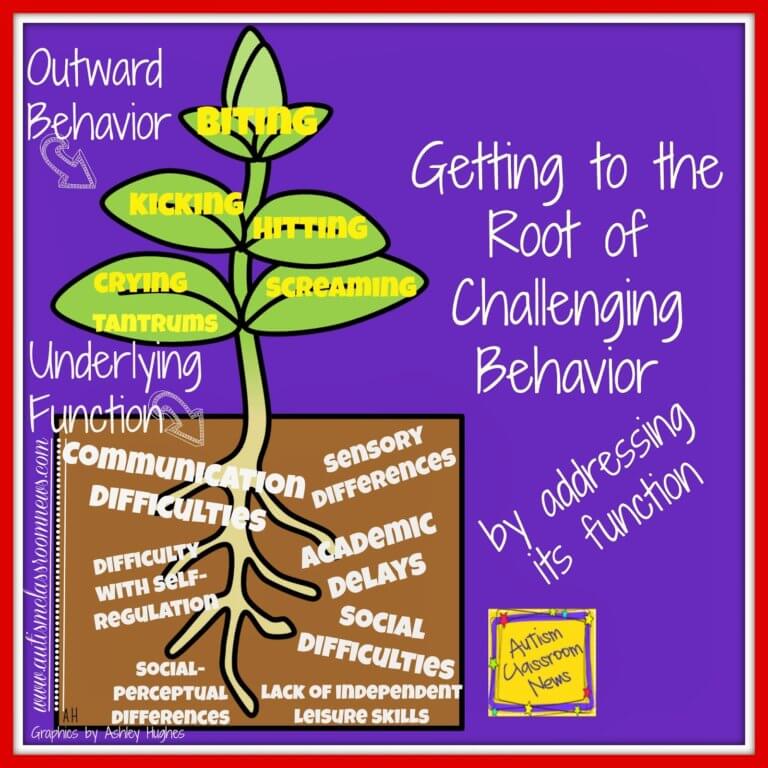 |
| Plant graphic by Ashley Hughes |
See this whole series, here.
So once you have a behaviorally supportive classroom in place, you may still have a student who exhibits challenging behaviors and needs more individual behavioral support. The first step in doing that is to trying to figure out the function of the behavior. While we tend to talk about the behavior by its form (e.g., biting, hitting), we need to focus on its function (i.e., why it is occurring) in order to improve it. The function of the behavior is more important than the form of the behavior because it tells us how to address it. Many
times people will ask me what to do about biting or spitting, but the question isn’t really what to do about those specific behaviors, but instead what to do about why they are happening. In taking a proactive approach, we want to determine what is happening in the environment that keeps the behavior occurring and hopefully what starts it off. If we know these pieces of information then we can make changes proactively in the environment and also teach the individual a better way to get what they need. For instance, if the student is hitting people because it gets them to attend to him or have a big reaction, we might want to create a situation in which they receive positive attention for appropriate behavior more often and also teach him how to ask for attention or gain a reaction in a more appropriate way. So, the class clown who loves the reactions he gets from his peers in response to his antics like standing on the table might be taught to tell jokes to get that same reaction in a more appropriate way.
In order to determine the function of the behavior we conduct a functional assessment. Essentially we collect information about what is happening before and after the behavior to try to figure out what the possible connections are to determine what to change. Here is some information about common functions of behavior.
Typically behavior occurs to either obtain something or escape or avoid something. Common things that can be obtained might be a desired activity or item that I either can’t ask for or am denied access to. Common things that might be avoided might be work demands, or social demands, or overstimulating environments. The person can also gain automatic reinforcers, like self-stimulatory behavior, or escape internal feelings like anxiety. We’ll talk in more detail about these functions, but behavior typically serves one of these purposes.
There is a strong relationship between communication skills and challenging behavior. Correlational
studies have shown that children with language impairments exhibit more
behavior problems than do typical children of the same age (Caulfield, Fischel, DeBaryshe, & Whitehurst, 1989;
Stevenson & Richman, 1978). Both
children with language impairments and typical children have been shown to
exhibit more problem behaviors when placed in situations that were considered
communicatively difficult for them than when their communication skills were
sufficient for the task (Caulfield, 1989). Experimental
studies in developmental disabilities have shown that increases in functional
communicative competence lead to decreases in problem behaviors (Carr & Durand, 1985; Horner & Budd, 1985; Steege, Wacker, Cigrand, Berg, Novak et al., 1990). Given that individuals with autism have difficulties with different types of communication behavior, it is not surprising that challenging behavior may result from this skill deficit.
Similarly, individuals with autism exhibit a variety of stereotypical behaviors and have a variety of sensory processing differences that may present challenges in their everyday life. These challenges for self-regulation (to increase and decrease incoming stimuli) can be related to challenging behaviors as well.
Many individuals, with and without autism, have difficulty regulating internal events like feelings of anxiety, depression and being overwhelmed. Sometimes challenging behavior is the outward manifestation of negative patterns of behavior due to cognitive processes like negative self-statements (i.e., I’m no good at this so I don’t want to try). Sometimes negative behaviors are an outgrowth of a difficulty with calming themselves or to reduce that internal anxiety.
Treating the function of the behavior instead of just the form makes the possibility of lasting changes more probable and makes it more likely that the behavior change will generalize. If you just treat the form of the behavior without addressing the underlying need for attention/reaction, sensory stimulation, avoiding difficult situations, etc. you are likely to just see a different form of behavior pop back up to serve that function. It’s like pulling a weed. If you don’t pull the roots and only get what you see, then the weed will just grow back.
So, in order to properly make a difference in improving the quality of life of the student and create lasting change to the challenging behavior, we have to know what the underlying function of the behavior is. And that is where we will pick up next time.
Until then, have you had experiences with behaviors that just keep coming back? How have you dealt with them?
Until next time,







